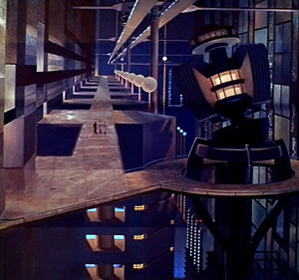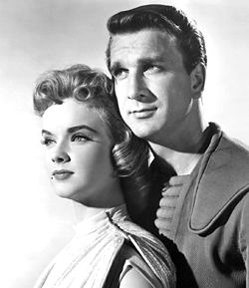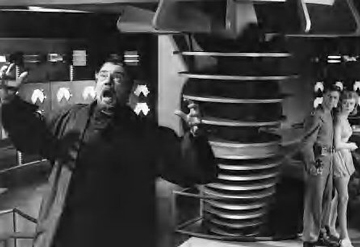
 |
|
|
|
Enthusiasts of literary science fiction were rightfully suspicious of the 1950s wave of monster and disaster- oriented fantasies popularly classed as sci-fi. After praising the fidelity of Destination Moon, Arthur C. Clarke had little use for the excesses and vacant science of its follow-up feature, When Worlds Collide. Many 50s films set off with the germ of a good speculative idea, but 1956's Forbidden Planet may be the lone effort that embraces the genre's potential, backed by the committed production resources of a major studio. The futuristic science on view is more than an excuse for a monster; entire sequences are dedicated to the exploration of abstract, wondrous concepts. It is also perhaps the first "out of this world" film that really shows what special effects can accomplish when a sizeable budget is allocated. Other sci-fi tales limited their depictions of spaceships and strange environments to a few scenes, or even a few shots. Forbidden Planet is the first film to take place entirely within a fantastic futuristic world, all of which had to be conceived and constructed from the stage floor up. 
The story drops us into the middle of an intergalactic adventure. Star cruiser C-57D returns to the planet Altair-4 to check up on the complement of the spaceship Bellerophon, an expedition that disappeared there ten years before. They find only Edward Morbius (Walter Pidgeon) and his daughter Altaira (Anne Francis), living alone with an amazing robot named Robby. Displeased by his host's insistence that they leave, Commander John Adams (Leslie Nielsen) presses for more information on the fate of the other Bellerophon colonists, and an explanation for Morbius' possession of scientific knowledge far in advance of Earth's. Morbius' secrecy and an awareness of a strange ghostlike presence on Altair-4 convince Adams that further investigation is required ... even when Morbius alludes to dire consequences. Forbidden Planet was a gift to fans hungry for a real space opera, with all the trimmings: an engaging script, romance and a congenial robot butler named Robby to amuse space-crazy kids. The film's middling box office performance can only be chalked up to a miscalculation of the public's interest in the genre. By 1956 audiences had been burned by plenty of cheap pictures hiding behind attractive ad campaigns. Space pictures were out of the mainstream, something for teenagers. In many homes weird and far out film fare wasn't exactly encouraged. The space movie did better business than other sci-fi pictures but not enough to justify its enormous cost: Earth vs. the Flying Saucers earned almost as much, but was made for relative peanuts. Forbidden Planet didn't break through, as had Disney's lavish 20,000 Leagues Under the Sea a little over a year before All that means nothing in the long run, for Forbidden Planet has persisted as the wonder film of its time. Kids hungry for a glimpse of a rocket or a neat special effect sat astonished at the film's surfeit of futuristic hardware. The previous year's This Island Earth seemed cheap by comparison, with its cartoonish Mutant and a spaceship interior that used glass bricks from the garden store. There's no waiting until Act 2 to see something unusual. A beautiful space cruiser glides through the frame in the very first shot, followed by one amazing visual after another: a planet turning in space, a glowing eclipse, a saucer landing in an eerie desert under a green sky. The characters are professional spacemen and not gawking civilians. And that's only the beginning of the wonders to be found on Altair-4. 
Forbidden Planet's vision is like the Monsanto Kitchen of the Future, with a little sex. Anne Francis' virginal Altaira communes telepathically with a deer and a tiger, providing a thematic harmony with the mythological. Altaira's miniskirt and coquettish ignorance of 'space wolves' only makes her more attractive to the space troopers, who might as well be Yankee sailors in an unfamiliar port. Allen Adler and Irving Block's story appealed to MGM's Dore Schary because it transcends space opera hardware. The back-story for the "Fatal Planet" still energizes the imagination. In the middle of the movie, the narrative stops dead still for what is essentially a fifteen-minute archeological rumination, an investigation of an extinct civilization. The ancient Krel are long gone but their technology lives on in the form of an amazing twenty-square mile power plant and machine complex that still functions under the surface of the planet. Morbius says that he's tapped a tiny portion of its knowledge, doubled his own brain power and used it to 'cobble together' wonders like Robby. (spoiler)The mystery of the Forbidden Planet is based on Freudian principles spelled out in the script as clearly as are Isaac Asimov's Laws of Robotics, the ethical 'prime directives' that govern Robby the Robot. Morbius reveals that the giant Krel machines were built to convert desires into physical realities by thought alone, without "instrumentalities." Each Krel citizen was set free of the physical limitations of their bodies, essentially becoming Demigods. The very human-seeming Krel didn't realize that they would be giving this power not only to their ethical conscious selves, but also to their unknown secret subconscious selves. Soon after the Krel activated their massive machine, they perished in an orgy of destruction and murder. Morbius has deciphered the secret of the Krell but is unaware that its lesson applies to him as well. When his fellow colonists disagreed with his 'enlightened' decisions, his subconscious manifested an Id Monster to destroy them. 
That's deep-dish stuff for a 'fifties space opera partially aimed at kiddies, and it opens many channels of thought. First, the Krel machines resemble a modern computer on a vast scale. They link the entire planet and its inhabitants in a World Wide Web that goes beyond communication to perform physical actions. It's as if a 'flame' E-mail had the power to punch the recipient in the nose. If the Web suddenly projected our unexpressed malign thoughts into violent actions, the result would certainly resemble the Freudian holocaust described in Forbidden Planet. Morbius is a dark character. His conscious mind has invented the benign Robby and built a beautiful oasis in the Altairian desert, but his elevated intelligence is mirrored by an unconscious sense of superiority and a lust for power. The Id is his Mr. Hyde, so to speak. The public Morbius honestly hopes that his visitors will leave before his paradise is disturbed. He's also a father engaged in a vague competition with his daughter's suitors. The expression "Nobody is good enough for my daughter" is easily interpreted as incestuous. In this case Morbius' subconscious wishes to keep defending its kin, even when that function is no longer wanted. To take this one step further, Forbidden Planet displays a refined version of the argument introduced in The Thing from Another World. Howard Hawks' film asserts that scientists live by cold rules of logic disconnected from spirituality, faith and sentiment. Science itself is therefore anti-humanistic and not to be trusted. Pure science, The Thing teaches, is an ideology unto itself, an unholy cult. Hawks' film came out strongly in favor of the patriotic, aggressive soldiers and against Dr. Carrington, the pacifist & defeatist scientist. Forbidden Planet's Morbius is a more refined Dr. Carrington, a liberal monster as defined by conservatives. He's an elitist convinced of the superiority of his viewpoint; other men are midgets by comparison. But Morbius is overblown with hubris. He's supremely intelligent, yet must have the lowdown about the Id and the 'primitive savage' explained to him by the relatively unintelligent (but socially conformist) Captain Adams. Only Adams brings up the subject of God and spirituality. Morbius is damned because his new intellect has him knocking on the door of God-hood, a religious taboo even when done for the most benign of reasons. Being Super-Smart feeds the Ego, which makes one disloyal to one's fellows (Adams even uses the word comrades) and thus untrustworthy. Dr. Morbius might be a reaction to Ayn Rand, an anti- Howard Roark. The common good requires the elimination of the occasional visionary egghead, as they tend to be wholly irresponsible. 
The conclusion reaffirms the necessity of moral suppression. Inner demons must be held in check by laws and limits. The super-science of the Krel was BAD, and God-fearing humans have no use for it. Nobody cries when Altair-4 is eradicated by an atomic blast. The Production Code gets its pro-religious message out as well. In space, God can hear you pray. Pauline Kael's Forbidden Planet review noted its clever adaptation of Shakespeare's The Tempest and also expressed her disappointment in the film's conception of a militaristic space-age future. Our brave spacemen tote ray guns; force is a first option. Outer space is an extension of the Wild West, where one anticipates violence and aggression in every encounter. Although Forbidden Planet's ideas run deep, its surface is firmly anchored in the middle of the Cold War. Warners' bright new Blu-ray of Forbidden Planet comes four years behind the company's HD-DVD release; we've been scanning the horizon for a Blu-ray edition ever since. The picture is spectacular in terms of color and sharpness. Color values are stable, as is the picture as a whole, and the greatly increased sharpness allows us a much better look at props, settings, and special effects. A couple of the shots of the C-57D circling Altair look better than their counterparts in the first Star Wars film... the magic of MGM's low-tech effects really jumps off the screen. The added resolution also allows us to scrutinize the faces of the crewmembers, even in the film's medium-wide shots. Now we can more easily pick out James Drury from The Virginian and Morgan Jones from Roger Corman's Not of this Earth. We do wish some extra resources had been available to spot-clean a few scenes, which are lightly peppered with a white dirt specks. We certainly wouldn't want an automatic program to subtly affect the look of the film, softening the image as we've noticed in some Universal discs. But some manual anti-dot work would have helped the impressive scenes using mattes and opticals. Somebody, bless 'em, did finally think to slightly enlarge the shots of Morbius' steel shutters closing, which have always betrayed flickering splice marks with every jump-cut panel banging into place. The extras port over all the goodies on the 2006 Ultimate Collector's Edition. They appear to be sourced in standard definition and of course encoded in HD on the single Blu-ray disc. A set of work print excerpts from the early Criterion disc originally came from a 16mm print sent to aid Louis and Bebe Barron in concocting their revolutionary synthetic soundscapes and 'electronic tonalities' score. A set of 'lost' scenes are just some effects outtakes, unaccountably transferred pan-scan -- or perhaps shot flat? "Lost Footage' doesn't seem an accurate description, but who's complaining? The extras include material old and new. We get two glimpses of Walter Pidgeon interacting with Robby while plugging the film on an MGM TV show. A new interview docu rounds up a number of critics and interested parties such as Dennis Muren, Phil Tippet and the welcome Bill Warren to express why Forbidden Planet was the effects 'n' fantasy touchstone for their later ambitions. Anne Francis is there as well. The relatively lavish TCM docu Watch the Skies! presents similar enthusiasm from top 'student filmmaker'-era directors -- Steven Spielberg, George Lucas, John Carpenter, Ridley Scott and James Cameron -- and extends the field of investigation to the whole decade of 50s sci-fi. Another new featurette examines the design and construction of Robby the Robot, still the most popular and recognizable movie robot and far more interesting and practical than those Star Wars pretenders. Actually, none of them are capable of using an ordinary flight of stairs, that I can see. Robby also makes an appearance in an entire episode of TV's Thin Man. A full second feature is the 1957 The Invisible Boy, in B&W and widescreen. Deserving of its own review, the film will strike viewers as a retreat to the level of typical 50s sci-fi, albeit with some fanciful touches. A scientist's mischievous son uses a super computer to make himself invisible and makes friends with a robot (Robby) that falls under evil influences, like the research robot tanks in Ivan Tors' GOG. Besides the expected robot rampage and army retaliation, the film shows the kid using his invisibility for some rather disturbingly naughty purposes ... like peeping into his parents' bedroom! All that is missing from the fancy 2006 DVD set is that edition's colorful tin "lunchbox" case and the little Robby the Robot toy. But sci-fi fans who have never seen the impressive Forbidden Planet on a large screen should be impressed by its spectacular thrills.
On a scale of Excellent, Good, Fair, and Poor,
Forbidden Planet Blu-ray rates:
Reviews on the Savant main site have additional credits information and are often updated and annotated with reader input and graphics. Also, don't forget the 2010 Savant Wish List. T'was Ever Thus.
Review Staff | About DVD Talk | Newsletter Subscribe | Join DVD Talk Forum |
| ||||||||||||||||||